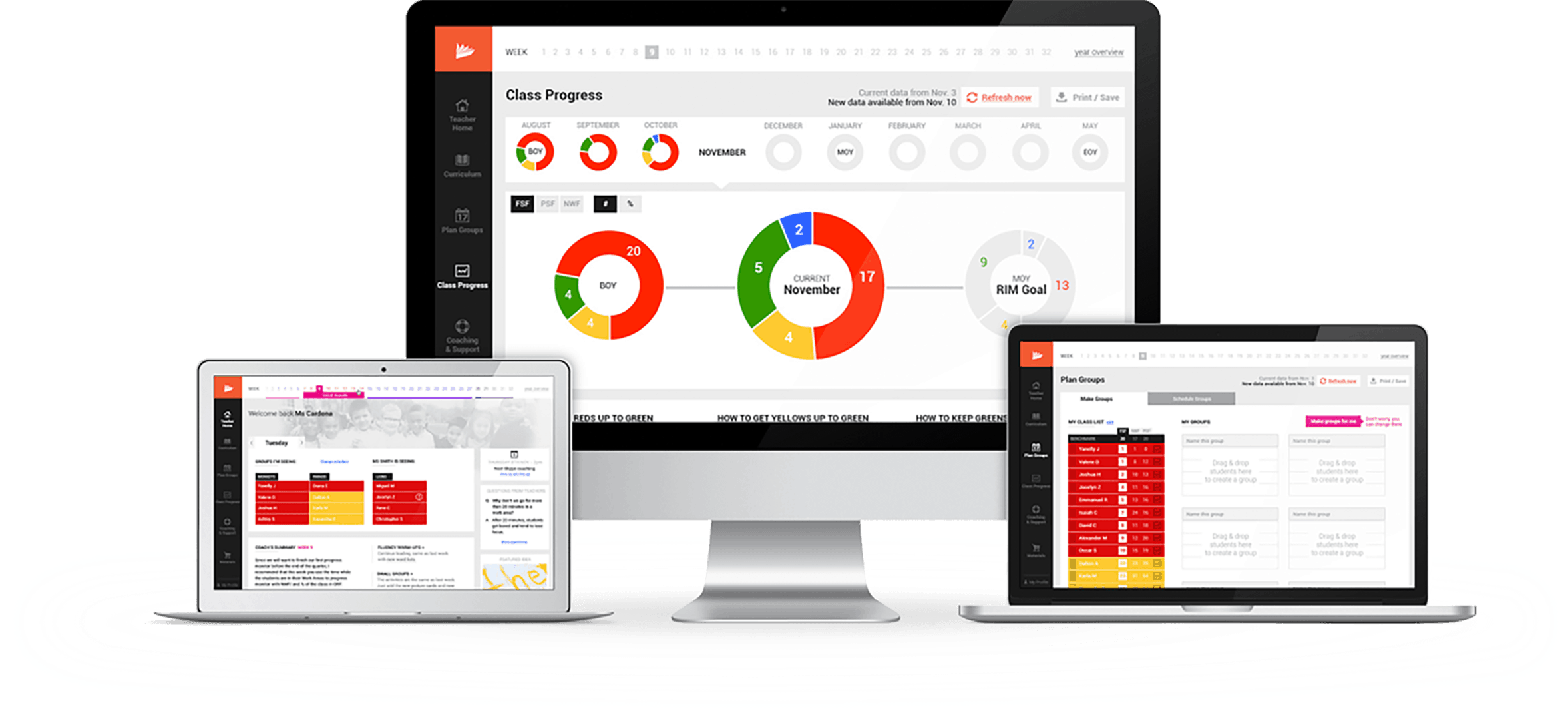A web platform to power reading success for every student.
For Reading In Motion
Reading In Motion
Sectors Served
Children, Education
Challenge
Operating successfully for over 30 years, Reading In Motion has a teaching model that works, but they still need to print binders of curriculum, word and picture flashcards, books and pamphlets, create DVDs and CDs, and provide support in the form of in-person coaching on grouping students for activities and using materials.
Solution
Design and build a custom content management system to distribute their curriculum to teachers in an organized, intuitive dashboard that saves planning time and exposes necessary data to make better teaching decisions. The platform imports teacher and student data from Access and delivers results based on state benchmarks, and provides curricula in text, video, audio and image formats.
Results
In partnership with CauseLabs and Greater Good Studio, Reading In Motion digitized their curriculum and activities. The Reading In Motion (RIM) teacher portal provides intuitive access to the weekly plan and allows teachers to quickly and easily find the resources they needed in one place. A group planning tool makes it easy to group students by skill level, and help from Reading In Motion coaches is always just a click away. We piloted successfully with 200 teachers and launched to all RIM classrooms in Fall 2015.

The classroom of the future is getting a new set of tools.
In 1983, Wi-Fi tablets and smartphones did not exist. Introducing digital technology into classrooms was a thing of science fiction and just on the fringes of our imagination. In those days, non-profits required high-touch volunteers or a large enough operating budget to hire staff to accomplish their mission. Expanding their reach meant growing bigger, requiring more volunteers or more capital.
Over the last 30 years that landscape has vastly changed. Scaling is now possible through technology in such a way that you can provide services and data to people across the globe, in real time and with much less effort. At the same time, human touch is still as important as ever. Balancing the two is where the art of great software for nonprofits comes into play.
Such is the case for Reading In Motion, whose mission is to help more children read by supporting teachers with a proven curriculum plan. The Reading In Motion curriculum has transformed the way students learn to read. They’ve shown growing success through their program, but now years into this mission, the classroom has changed. Blackboards have turned to whiteboards and interactive digital Promethean boards. Laptops and mobile tablets have been provided for teachers and, in some schools, students too. Enterprise apps are being built for curriculum and in-class activities.
The Reading In Motion program relied on binders with pages and pages of instruction, physical DVDs and CDs, and kits with materials to perform the activities—all of which needed to be delivered to teachers either in person or via mail. Along with these materials, Reading In Motion employs a coaching model, which needs to scale as they accept more schools and teachers. Everything in their current model works. The exploration into digital tools was not to fix anything that may have been broken, but rather a recognition of the advantages that technology could provide. They weren’t quite sure what they were diving into, but they did know that it was the right time to be evaluating digital tools.
In 2013, they reached out to Greater Good Studio, a Chicago-based social impact design firm, who led them through the human-centered design process, which focuses on the user experience. Often times organizations are asking “how” they should build rather than “what” or “if” they should build. Greater Good Studio expertly guided Reading In Motion through this process. They performed user interviews to prototype designs and testing to validate some of their assumptions. The resulting design detailed a platform that allowed teachers to quickly and easily see their student’s test scores against benchmarks throughout the year, group them into like-skilled groups and schedule groups based on literacy needs. It also offered a wealth of features requested from the teacher interviews and allowed Reading In Motion to evaluate and prioritize each feature for a pilot program.

A scalable digital strategy.
When CauseLabs joined the partnership in June 2014, the “what” and “if” questions had been answered. It was our turn to transform ideas into reality. Despite all the planning that goes into a project like this, it is not unusual to continue to encounter new decisions and pivots during implementation. Staying open to necessary changes and lean in our development process is important to ensure that we build the right tool for the right reasons. It is our practice to be tool agnostic, choosing the right platform for the project that will yield the greatest impact. It is also our belief that technology should not outsmart the users, but empower them.
My Reading In Motion was built to be intuitive, informative and inclusive. In under three months, CauseLabs has succeeded in developing a platform that does more than facilitate data visibility and efficient group scheduling.
My Reading In Motion also has digital copies of the curriculum, notes on daily and weekly activities, digital photos and word lists, audio and video files, all available on teachers’ laptops or tablets for ease of portability around the classroom. It provides 24/7 guidance, coaching tips and activity planning for various types of curriculum in both English and Spanish.
The platform will save teachers hours in administration of data and planning each week, allowing them to maximize direct instructional time with their students, which is the key to success for the Reading In Motion program. So the next time students step into a Reading In Motion classroom, their teachers will have the tools they need.
“In CauseLabs, we’ve found a partner in our arts-based literacy mission, not just a technology vendor. The CauseLabs team continues to bring passion and new ideas that demonstrate a commitment to our program’s usability.”
Karl Androes
Executive Director, Reading in Motion